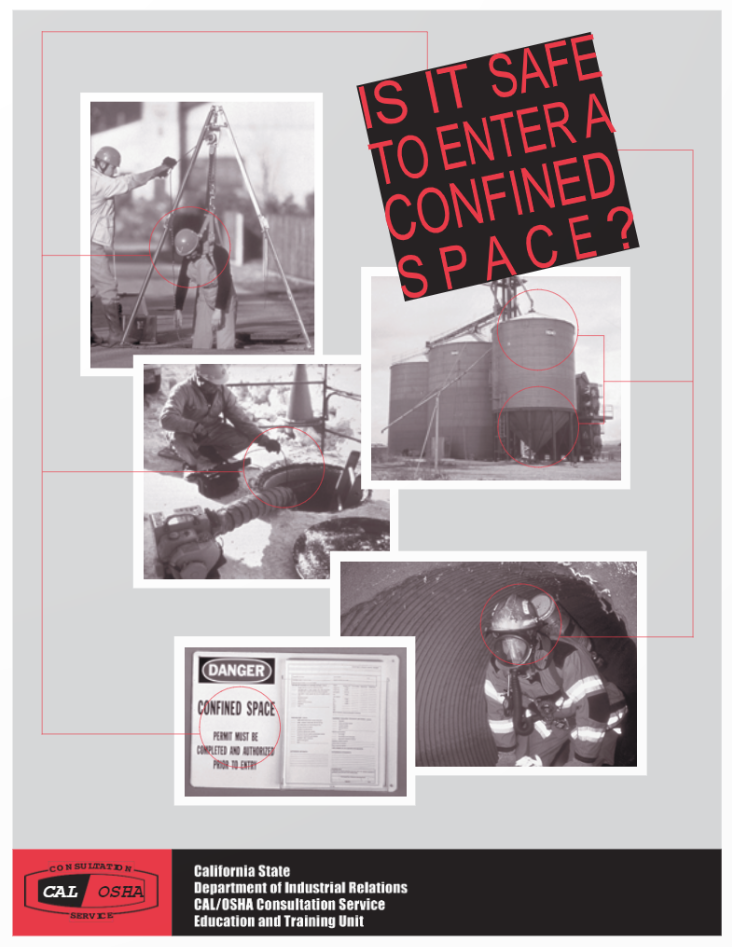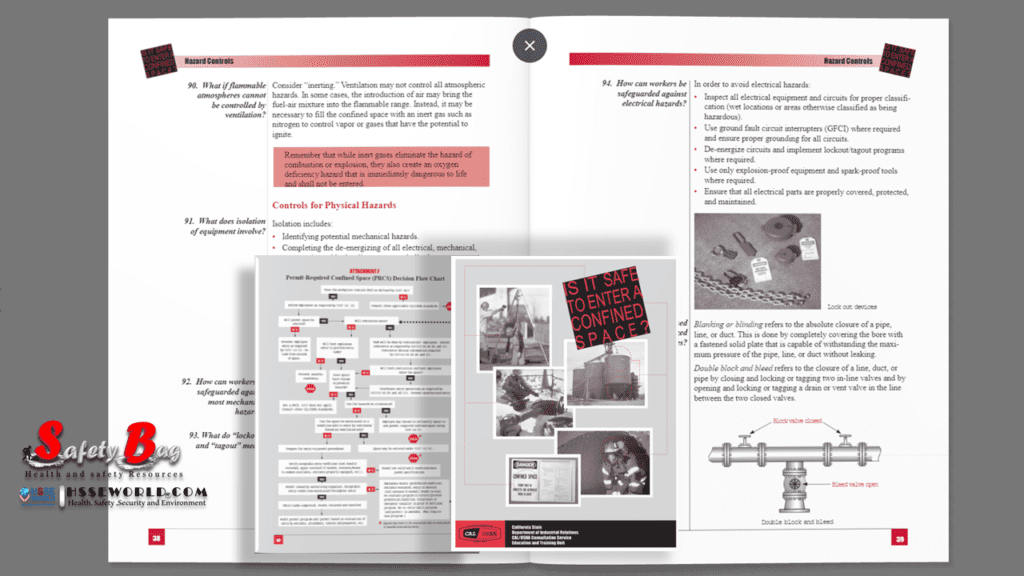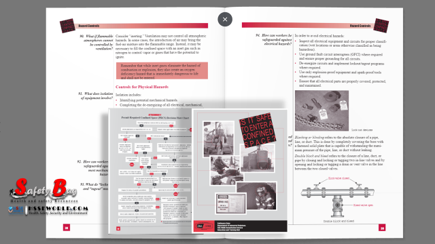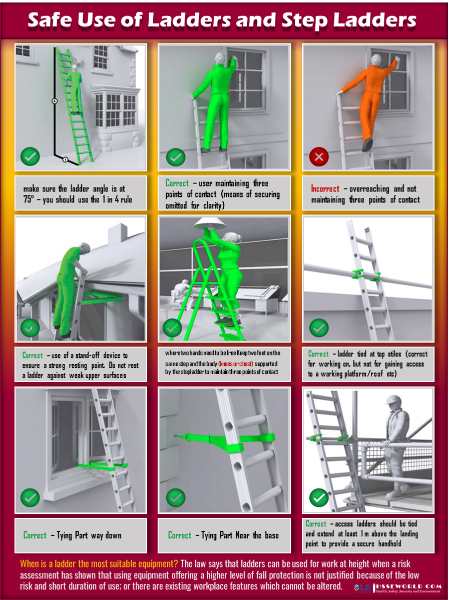THIS Confined Space Guide has been developed to explain the hazards of confined space work and to assist employers in establishing and maintaining an effective confined space program. By implementing such a program, both employers and employees will be able to:

- Recognize, evaluate, and control confined space hazards.
- Save lives and protect employees from job-related injuries and illnesses.
- Promote safe and effective work practices.
- Reduce preventable workers’ compensation losses.
- Comply with the law.
Thhis Guide contains information, definitions, and requirements for entry into permit-required confined spaces (Section 5157). To call the attention of employers whose operations and industries are regulated under Section 5158, the confined space definition and requirements are distinctively highlighted. To clarify and facilitate the understanding of confined space issues, the guide presents the information in the format of questions and answers and includes a list of the most frequently asked questions.
For easy reference, the guide is separated into six distinct main
sections:
- Rescue, addresses questions about various types of rescue operations, rescue training, and equipment, along with the importance of well-planned rescue activities.
- Definitions and Basics, which contains essential definitions of terms such as confined space, immediately dangerous to life and health (IDLH), and the permissible exposure limit (PEL). This section also addresses entry issues and issues relating to permitting evaluation (including permit-required confined space reclassification, alternate procedures, and hot work permits).
- Confined Space Hazards, which addresses specific atmospheric and physical problems that can be encountered when working in confined spaces as well as questions relating to Material Safety Data Sheets and atmospheric testing.
Also Read: Photo of the day: Safety Equipment for Confined Spaces

- Hazard Controls, which addresses means of preventing accidents and controlling other problems by eliminating or controlling confined space hazards.
- Training and Education, which addresses the importance of gaining a new understanding of critical confined space issues and acquiring practical skills for successful confined space work. This section applies to the supervisor, the entrant, and the attendant. Frequently Asked Questions, which contains a variety of other questions about miscellaneous confined space issues.
(Also Read: Permit-Required Confined Spaces )
At the back of this guide, there are six attachments intended to further assist employers who are starting to learn about confined spaces or for those who wish to improve an existing program.
Attachments A through D provides samples of hot work and permit-required confined space entry forms, Material Safety Data Sheets, atmospheric monitoring equipment information, and general testing protocols. Attachment E, “Setting Up a Permit-Required Confined Space Program,” contains easy, step-by-step instructions for required and suggested actions in the implementation of a confined space program that meets regulatory requirements. Attachment F, “Permit-Required Confined Space (PRCS) Decision Flow Chart,” helps employers to determine the required entry procedure as defined by the confined space standard.
This guide does not list every conceivable confined space hazard. It is not intended as a legal interpretation of federal or state standards and should not be used as a substitute for training.
Also Read:Video: Employee safety in confined spaces
Contents
The content of the -Is it Safe to Enter Confined Space?
- Acknowledgments
- Regulatory Requirements
- Introduction
- Fatal Facts
- Rescue
- Emergency
- Self-Rescue, Non-Entry, and Entry Rescue
- Rescue Training and Plan
- On-Site Rescue Team vs. Off-Site Rescue Team
- Rescue Equipment
- Definitions and Basics
- General Terminology
- Confined Space; Immediately Dangerous to Life or Health (IDLH); Permissible
- Exposure Limits (PEL); Entry
- Permit Evaluation
- Permit-Required vs. Non-Permit Confined Space; Space Reclassification; Alternate Procedures; Permit-Required Confined Space Program (Hot Work and Host Employer-Contractor)
- Confined Space Hazards
- Atmospheric Hazards
- Oxygen Deficiency/Enrichment; Combustible/Flammable/Explosive Gases and Vapors; Combustible Dust; Toxics; Material Safety Data Sheets (MSDS); Monitoring-Air Sampling and Equipment
- Physical Hazards
- Mechanical; Entrapment; Engulfment; Other Types of Hazards
- Hazard Controls
- Controls for Atmospheric Hazards
- Ventilation; Respiratory Protection; Other Control Measures
- Controls for Physical Hazards
- Isolation (Mechanical, Electrical, Pressurized Lines, Ducts, or Pipes); Other
- Control Measures
- Personal Protective Equipment and Tools
- Communication System
- Training and Education
- Entry Team
- Supervisor; Entrant; Attendant
- Frequently Asked Questions
- Attachments
- A – Hot Work Permit Sample
- B – Atmospheric Monitoring Equipment and General Testing Protocol
- C – Confined Space Entry Permit Sample
- D – Material Safety Data Sheet Sample
- E – Setting Up a Permit-Required Confined Space Program
- F – Permit-Required Confined Space (PRCS) Decision Flow Chart
- References
- Evaluation
- Cal/OSHA Consultation Service Offices Back cover
Download the book
E-Books: Is it Safe to Enter Confined Space?
Photo of the day: 5 Essential outcomes of an effective leadership survey process
More Downloads
- E-Books: Healthcare Hazard Control & Safety Management
- E-Books: Safety, Health and Working Conditions Training Manual
- E-Books: Energy Efficiency in Water and Wastewater Facilities
- E-Books: Fire Service Features of Buildings and Fire Protection Systems
- E-Books: Evaluation of Fire Safety free download
- E-Books: PPE for Chemical, Biological, and Radiological Hazards free
- E-Books: Changing the Workplace Safety Culture free download
- E-Books: Site Emergency Planning Workbook
- E-Books: Load Restraint Guide
- E-Books: Essential Practices for Creating, Strengthening, and Sustaining Process Safety Culture
- E-Books: System Safety Engineering and Risk Assessment
- E-Books: Permit-Required Confined Spaces
- E-Books: Is it Safe to Enter Confined Space?
- E-Books: 5-Minute Workplace Safety Talks
- E-Books: Safety Culture and High-Risk Environments
- E-Books: Practical Guide to Industrial Safety
- E-Books: Slip, Trip, and Fall Prevention for Healthcare Workers
- E-Books: Health and Safety at Work Key Terms
- E-Books: Fundamentals of Process Safety Engineering
- E-Books: Gas Detection Hand Book
- E-Books: Occupational health and safety management systems ANSI-AIHA-z10-2012
- E-Books: Hot Work on Drums and Tanks
- E-Books: Human Fatigue Risk Management
- E-Books: Guidelines for the provision of facilities and general safety in the construction industry
- E-Books: Handbook of Training in Mine Rescue and Recovery Operations ( 2021)
- E-Books: Code of Practice for the Safe Use of Lifting Equipment – Edition 9 (Nov 2019)
- E-Books: Free Forklift Health and Safety Best Practices Guideline
- E-Books: Handbook of Hazardous Chemical Properties
- E-Books: Human Performance Improvement through Human Error Prevention
- E-Books: Principles Of Fire Risk Assessment In Buildings
- E-Books: Investigation of Occupational Accidents and Diseases
- E-Books: Radiation Protection and Safety in Industrial Radiography
- E-Books: Basic Guide to System Safety, Third Edition
- E-Books: Food Safety Management-A Practical Guide for the Food Industry
- E-Books: Safety identification: Escape and evacuation plan signs- ISO 23601
- E-Books: Safety at Work
- E-Books: The Safety-Critical Systems Handbook 4th edition
- E-Books: Fundamental principles of occupational health and safety
- E-Books: Fire Safety Risk assessment Guide – Sleeping Accommodation
- E-Books: Mental health at work series
- E-Books: Live Fire Training: Principles and Practice
- E-Books: Pre-Startup Safety Review Guide
- E-Books: Fire and Emergency Drill Manual and Building Inspection Guide
- E-Books: Health and Safety: Risk Management 5th edition
- E-Books: Fire Protection systems -Third edition 2021
- E-Books: Fire Safety Logbook templates
- E-Books: From Accidents to Zero
- E-Books: Electric Safety Practice and Standards
- Your steps to chemical safety
- E-Books: Ergonomics and Psychology Developments in Theory and Practice
- E-Books: HAZOPS Should BE fun-The Stream-Based HAZOP
- E-Books: Safety Health and Environmental Auditing
- E-Books: A Quick Guide to Health and Safety
- E-Books: Occupational Ergonomics A Practical Approach
- E-Books: Job Hazard Analysis A Guide for Voluntary Compliance and Beyond
- E-Books: Electrical Safety of Low Voltage Systems




